
GENTLE GIANTS OF THE FORESTS


There are few wildlife encounters as profound or humbling as locking eyes with a mountain gorilla in its misty highland home while on an African safari. These great apes, one of four gorilla subspecies, share more than 98% of our DNA, and their human-like behaviour, deep social bonds and intelligent gaze create a powerful sense of connection. Mountain gorillas (Gorilla beringei beringei) live only in the cloud forests of the Virunga Massif and Uganda’s Bwindi Impenetrable National Park, in troops led by dominant silverbacks who mediate troop movements, resolve conflicts and protect their families. Watching them forage, play or care for their young in the wild is a privilege that leaves a lasting imprint on every traveller fortunate enough to witness it.
With fewer than 1,100 individuals remaining, mountain gorillas are classified as Endangered, their survival a hard-won conservation success built on community collaboration, veterinary care, research and tightly regulated tourism. Trekking to see these gentle giants has become the ultimate bucket list experience – a journey through emerald montane forests where mist clings to the canopy and every rustle might reveal a primate of extraordinary presence. It’s not just another wildlife sighting; it’s a soul-stirring communion with one of our planet’s most iconic species, making it a quintessential African safari and a testament to the power of sustainable, ethical travel.
“The thrill of trekking for mountain gorillas in the astonishingly beautiful misty highlands of East Africa is not difficult to explain. Quietly observing these gentle giants as they go about their day is a once-in-a-lifetime opportunity for a privileged few, and to be treasured beyond compare. If you are lucky enough to exchange glances with one of the troop, you will become aware of that narrow genetic gap between our two great ape species. The exchange of recognition, of awareness, is apparent. This is not the heart-thumping primordial fear one experiences when a twitchy lion gives you the stare, or that adrenaline rush when that cantankerous old buffalo bull rises from the bluebush thicket and fixes you with his myopic glare. No, this is different. This is gentle to-and-fro communication at a spiritual level.”
~ Simon Espley, CEO of Africa Geographic
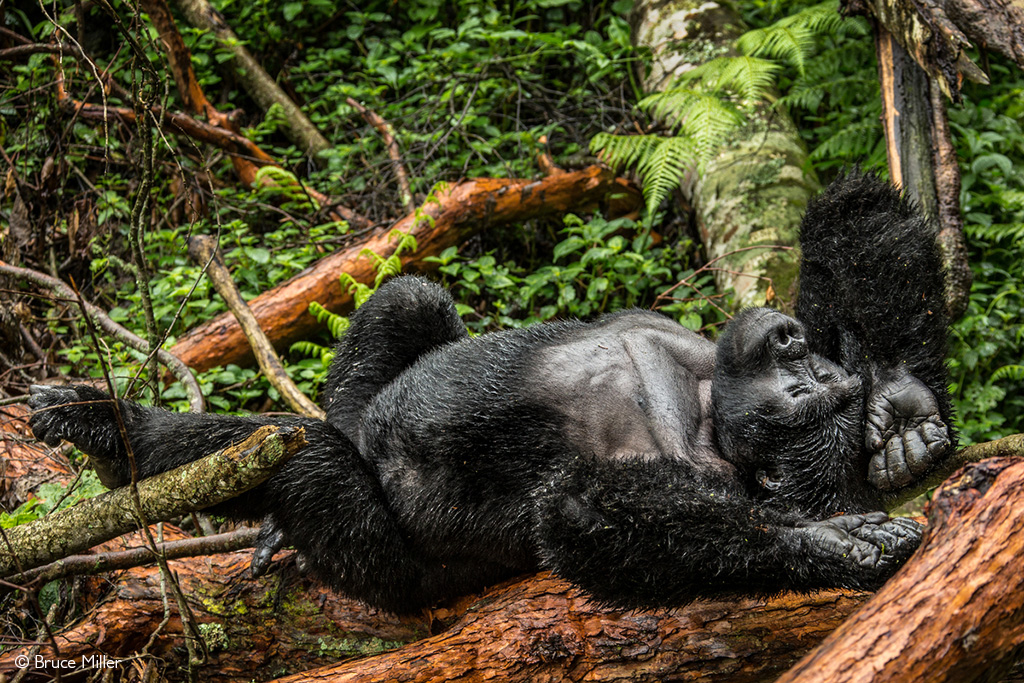
What’s in a name?
There are two gorilla species – the eastern gorilla (Gorilla beringei) and the western gorilla (Gorilla gorilla).
There are two subspecies of the eastern gorilla, namely the mountain gorilla (Gorilla beringei beringei) and the eastern lowland/Grauer’s gorilla (Gorilla beringei graueri). There are two subspecies of the western gorilla, namely the western lowland gorilla (Gorilla gorilla gorilla); and the Cross River gorilla (Gorilla gorilla diehli). Mountain gorillas, the focus of this article, are found in Rwanda, Uganda, and the Democratic Republic of Congo (DRC).
Conservation status and distribution
The mountain gorilla population is estimated at 1,063 individuals, up from fewer than 900 individuals in 2010. This increase is primarily due to the cooperation from communities that live near mountain gorillas, NGOs that operate on the ground, and tourists, who pay in hard currency for the privilege of trekking to see mountain gorillas.
Mountain gorillas are found in two populations in Africa:
1. An estimated 604 individuals in the Virunga Massif – which includes Volcanoes National Park (Rwanda), Virunga National Park (DRC) and Mgahinga Gorilla National Park (Uganda);
2. An estimated 459 individuals in Bwindi Impenetrable National Park (Uganda) were recorded in a 2018 census. A new census began in Bwindi in May 2025 and is still ongoing.
As a result of the above conservation successes, the mountain gorilla was reclassified in the IUCN Red List as ‘Endangered’ in 2018 (facing a very high risk of extinction), improved from its previous category of ‘Critically Endangered’ (facing an extremely high risk of extinction).
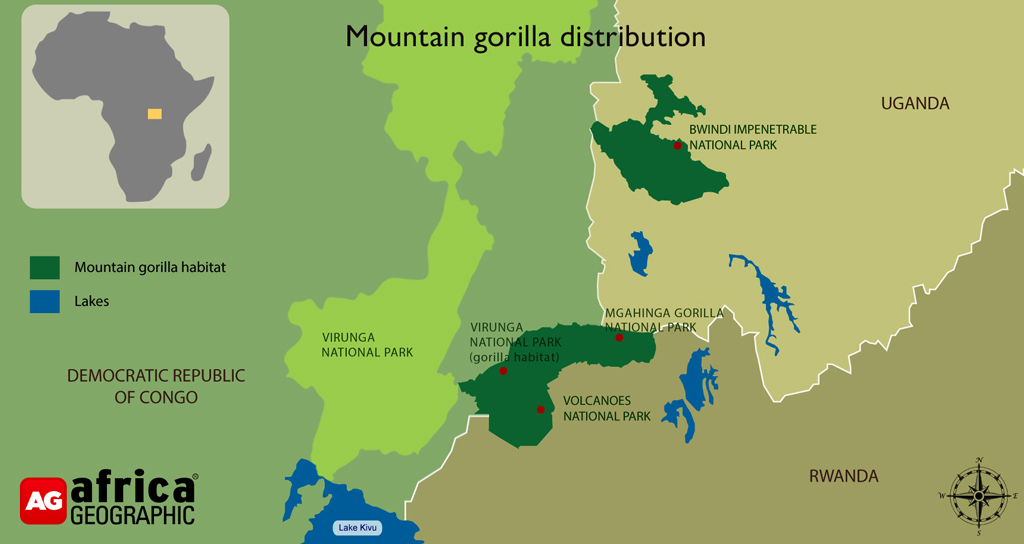
Major threats to mountain gorillas
Factors contributing negatively to mountain gorilla conservation status include poaching for bushmeat, the continuing political instability in parts of the Democratic Republic of Congo (DRC), habitat loss/degradation, and the risk of disease transmission by humans, domestic animals and livestock. There is a distinct possibility that the subspecies could experience a 25% reduction in the next 20 years.
As of 2025, tourism in DRC’s Virunga National Park remains suspended due to ongoing armed conflict. Key access routes are closed, park staff have been evacuated, and gorilla trekking and other ecotourism activities have been halted in conflict zones.
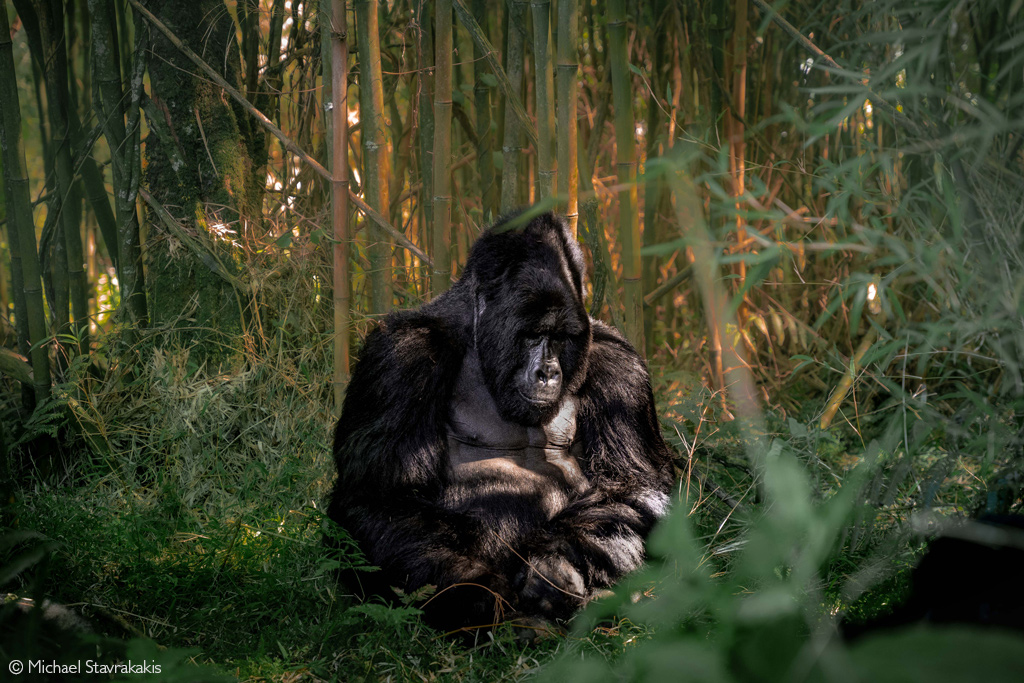
Mountain gorilla habitat loss
The primary threat to mountain gorillas comes from forest clearance and degradation, as the region’s growing human population struggles to eke out a living. Conversion of land for agriculture and competition for limited natural resources, such as firewood, lead to varying degrees of deforestation. Also, the harvesting of charcoal, as a fuel source in cooking and heating, has also destroyed gorilla habitat.


Diseases, immunity and survival
Gorillas are vulnerable to human diseases, and when coming into contact with humans, can pick up a variety of illnesses, from the common cold to Ebola, all of which can prove fatal.
Following the COVID‑19 pandemic, gorilla tourism protocols have been tightened to protect both humans and primates from disease transmission. Measures such as mask-wearing and increased distance rules have significantly reduced the incidence of respiratory illness in habituated gorilla groups.
As gorillas have not developed the necessary immunities, first-time exposure to an illness or virus that is relatively innocuous to humans may devastate an entire population. However, studies have found that mountain gorillas that are regularly habituated with researchers and tourists have survived better than unvisited gorillas; they benefit from the greater protection available in those areas and from regular monitoring. Increased survival is also largely due to better veterinary care of sick and injured gorillas.

Poaching and bouncing back
In recent years, there has been increased targeting of mountain gorillas for bushmeat and the pet trade. Gorillas can also be caught and harmed by snares set for other animals.
Fortunately, non-profit organisations such as Gorilla Doctors provide on-the-ground veterinary care to gorillas in their natural habitat, treating injuries from snares, fights, or other ailments. They also play a role in rescuing and rehabilitating orphaned gorillas. Their mandate is to monitor the populations of mountain and Grauer’s gorillas – the two subspecies that live in the Albertine Rift – and, when the life or well-being of an individual gorilla or family group is at stake, intervene.
Innovative community-based conservation projects also continue to thrive around gorilla habitats. Initiatives such as the rehabilitation and rewilding of orphaned gorillas are helping to support both wildlife and the local economy.
As a result, mountain gorilla conservation is one of Africa’s greatest wildlife success stories, with population numbers rising steadily thanks to decades of collaborative effort. This progress is the result of intensive monitoring, habitat protection, community-driven conservation, and carefully managed tourism that directly funds their protection.

Moving mountains
Mountain gorillas live for 35–40 years in the wild, in troops with home ranges that vary from three to 15 km². They typically move only about 500 metres per day, due to the mountainous terrain and readily available food. Male mountain gorillas usually weigh 195kg with an upright standing height of 168cm. Females stand at 100kg and 140cm. They live primarily on the ground but will climb sturdy trees in pursuit of food.
Mountain gorilla troop dynamics
Mountain gorillas live in troops of up to 20 individuals, made up of one adult male who is usually older than 12 years (often called a ‘silverback’ because of the silver fur on his back), a few adult females and their offspring of various ages. Some troops will have more than one mature male, but only one leader/alpha male. The subordinate male (often called a ‘blackback’, and typically 8–12 years old) plays a backup role and will assume the leadership role if the silverback dies. Both males and females tend to emigrate from their natal groups, with females leaving at an earlier age than males.
The silverback is the troop leader, making all the decisions, mediating conflicts, determining the group’s movements between feeding and resting/sleeping sites, and taking responsibility for the troop’s safety and well-being. The bond that a silverback has with his females forms the core of gorilla social life. Females seek relationships with males for mating rights and for protection against predators (primarily leopards) and outside males (which may kill young gorillas). If a mother dies or leaves the group, the silverback will often look after her abandoned offspring. Experienced silverbacks are known to remove poachers’ snares from the hands or feet of their group members.
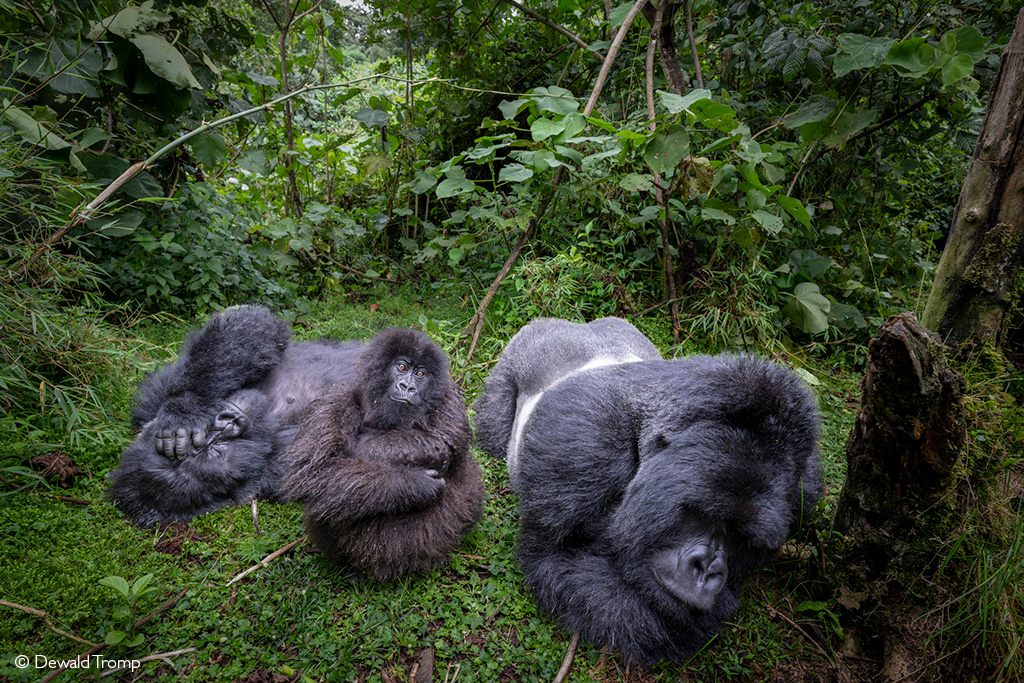
Aggressive encounters between males and females in a troop are rare, but females can act aggressively towards each other (particularly if not related). Conflicts are most often resolved by threat displays intended to intimidate, including hooting, rising onto the legs, throwing of sticks and leaves, chest-beating, kicking with one leg, sideways running on all fours and thumping the ground with the palms.
Rival silverbacks from different troops have been known to kill each other during territorial battles, where they use their huge canines as effective weapons. When a silverback dies, his position in the group may be taken over by one of the younger group males, failing which a new silverback may join the group, often killing all of the infants of the dead silverback.

Mountain gorilla nests, food and reproduction
Mountain gorillas make nests on the ground for daytime resting and for sleeping at night. The nests are made of a loose pile of branches and leaves. Babies sleep with their mothers and start building their own nests when they are about three years old.
Mountain gorillas are vegetarians, eating leaves, stems, pith, and shoots, with fruit making up a small part of their diet. Protein in the form of insects and grubs makes up about 3% of the diet.
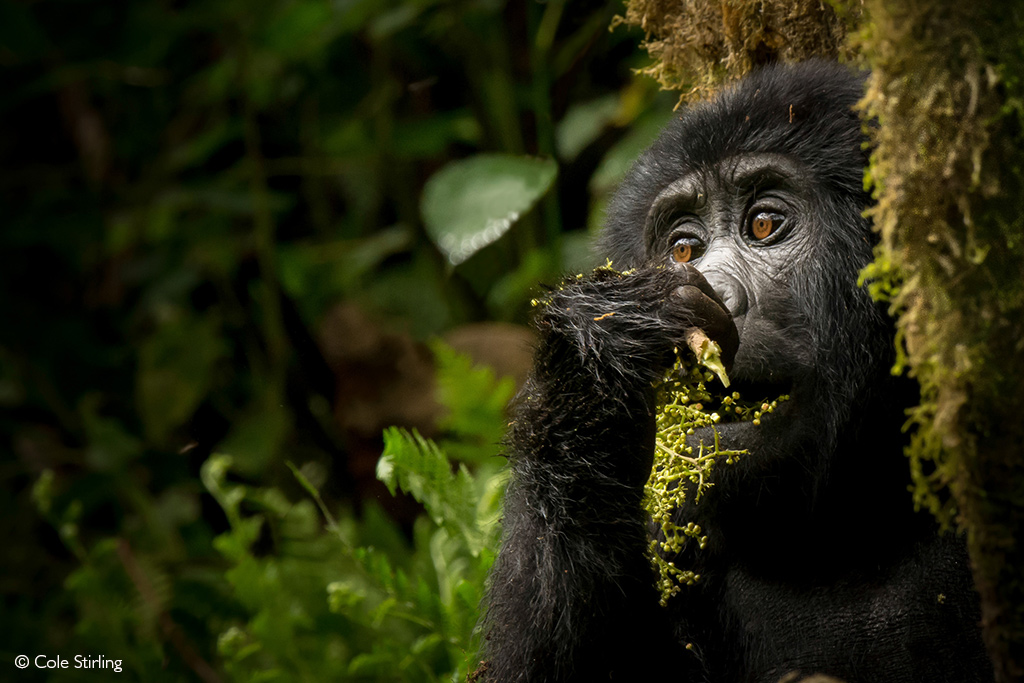
Mountain gorillas mate year-round, once they reach sexual maturity, which is at the age of 10 to 12 years for females and 11 to 13 years for males. The gestation period lasts 8.5 months, and females can give birth every four years.
Baby mountain gorillas are, like humans, vulnerable and dependent on their mothers for survival. Male gorillas are not active in caring for the young (unless the mother dies), but they do play a role in socialising them with other youngsters and protecting them from aggression within the group. Infants remain in contact with their mothers for the first five months, sleeping in the same nest and suckling at least once per hour during that time. After five months, infants begin to move away from their mothers, gradually gaining independence. By the third year, juveniles are weaned and sleeping in separate nests from their mothers.

Great communicators
Mountain gorillas use a variety of distinct vocalisations to communicate within their densely forested home. These include grunts and barks while travelling, screams and roars to signal alarm or warning, and rumbling belches of contentment during feeding and resting periods.
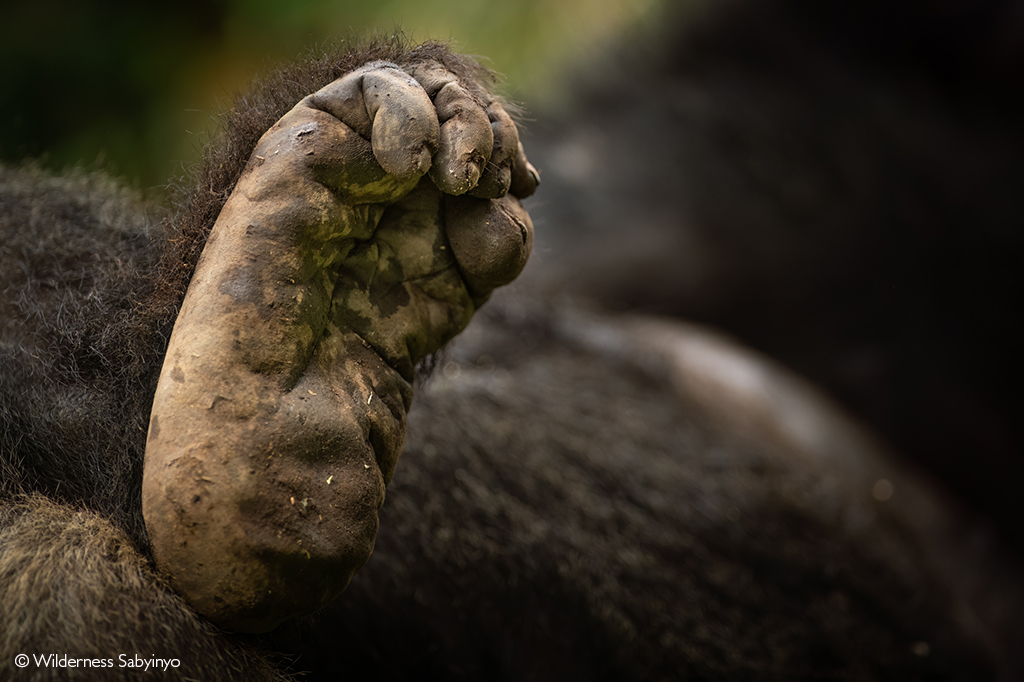
 Want to see gorillas on your next African safari? Gorilla trekking has been described by many as a life-changing experience. Browse our top gorilla safaris here.
Want to see gorillas on your next African safari? Gorilla trekking has been described by many as a life-changing experience. Browse our top gorilla safaris here.
Gorilla trekking
Despite their size and strength, mountain gorillas are gentle, intelligent creatures whose lives revolve around complex social interactions, quiet routines, and deep familial bonds. Observing them in the wild reveals not only their physical grace but also their emotional depth, as well as how they nurture their young, resolve disputes, and express curiosity or contentment through subtle gestures. These moments of connection are what make gorilla trekking such an extraordinary experience: a rare opportunity to witness one of our closest living relatives living freely, on their own terms, in one of Earth’s last remaining montane rainforests.
The best and most practical places to go mountain gorilla trekking are in the dense, mountainous forests of Rwanda and Uganda. Rwanda’s Volcanoes National Park offers the most accessible and luxurious experience, with well-maintained trails and high-end lodges, ideal for travellers short on time. Uganda provides a more immersive and adventurous option in Bwindi Impenetrable National Park, while Mgahinga Gorilla National Park provides a quieter alternative with stunning scenery and fewer crowds.
For the truly intrepid, Virunga National Park in the DRC offers a raw and rugged trek (when open for trekking) – best check in with your safari expert before settling on a safari here. Each destination offers its own magic, whether it’s the ease and polish of Rwanda, the jungle depth of Uganda, or the edge-of-the-map thrill of the DRC.
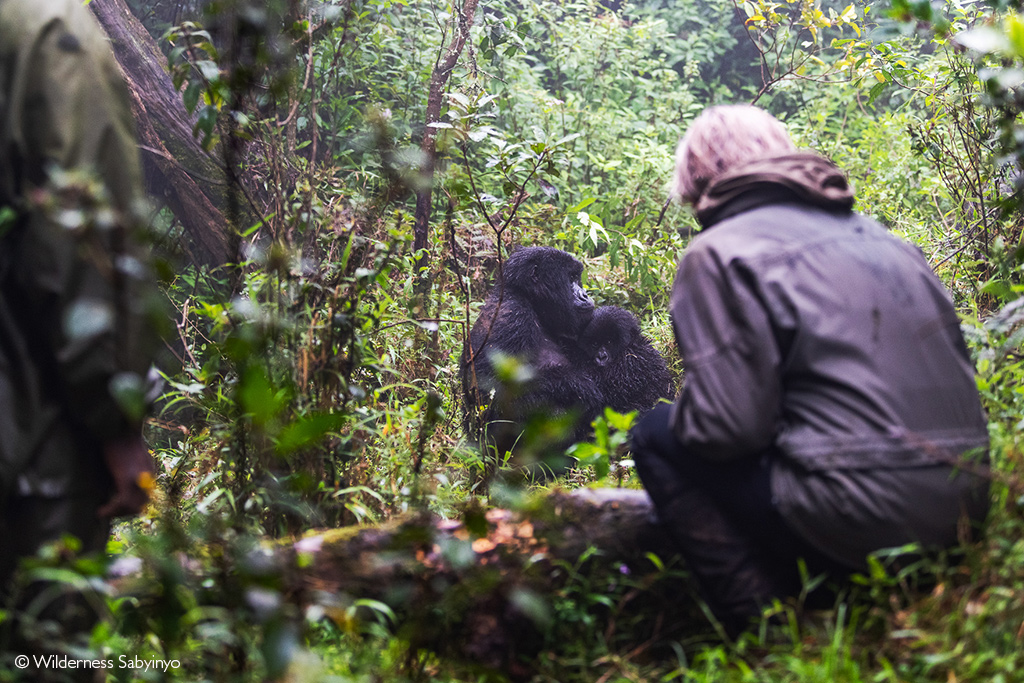
Final thoughts
There is an uncomfortable paradox unfolding in the mountain gorilla conservation space, which highlights the role that humans play on both sides of the equation. On the one hand, humans pose the greatest threat to gorillas, and, at the same time, humans represent the most viable conservation solution.
Mountain gorilla populations are now slowly trickling upwards, thanks to the dedicated work of so many passionate people on the ground – from locals who live amongst these gentle giants to government conservation agencies, researchers, non-profit entities and paying tourists. Let’s savour this rare victory in the ongoing war to keep Earth’s charismatic species, in fact, all species, safe from extinction.

Further reading
- Bwindi is the fairy-tale forest we dreamed about as children; it is also where you can meet and spend time with gentle mountain gorillas
- To bring medical support to mountain gorillas, a group of veterinarians brave one of the world’s most dangerous national parks. Read more about Gorilla Doctors here
- Mgahinga Gorilla NP, on the forested slopes of 3 extinct volcanoes in Virunga Conservation Area, is an important home to mountain gorillas. Read more about Mgahinga Gorilla NP here
- Trekking through the ancient rainforests of Bwindi, Uganda to find mountain gorillas brings Ryan Biller face-to-face with a childhood dream. Read more about his journey walking with gorillas here
- Virunga NP offers unparalleled biodiversity. Rain forests, gorillas, endemic birds, bubbling volcanoes, and safari favourites await. Learn about the wonders of Virunga
- Volcanoes National Park is a leading gorilla trekking destination in Africa. This volcanic landscape offers stunning scenery & biodiversity. Read more about Volcanoes here
To comment on this story: Login (or sign up) to our app here - it's a troll-free safe place 🙂.![]()




